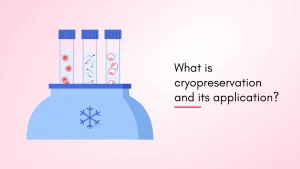In the ever-advancing field of assisted reproductive technologies (ARTs), oocyte vitrification has emerged as a groundbreaking solution for individuals looking to conserve their fertility potential. This innovative technique allows for successfully freezing and storing unfertilised eggs. It offers a powerful tool for those facing various life circumstances or medical conditions that may adversely affect their ability to conceive naturally. As we delve into the intricacies of oocyte vitrification, we unravel a world of possibilities, empowerment, and hope for those embarking on their journey to parenthood.
What is Oocyte Vitrification?
Oocyte vitrification, also known as egg freezing or cryopreservation, is a cutting-edge process that enables the long-term preservation of a woman’s unfertilised eggs. This technique involves rapidly freezing the eggs to prevent ice crystal formation, which could damage their delicate structures. By transforming the eggs into a glass-like, vitrified state, their cellular integrity is maintained, allowing for successful thawing and subsequent fertilisation when the time is right.
Suggested Read: Freezing Eggs: Procedure, Cost, and Anticipations
What is the Need for Oocyte Vitrification?
The decision to pursue oocyte vitrification can stem from many reasons, each uniquely personal and significant. Let’s explore some of the most common motivations:
Fertility Preservation for Career Planning
Many women prioritise their educational and professional pursuits in today’s fast-paced world, often delaying childbearing until later in life. Oocyte vitrification allows them to freeze their eggs at a younger age, preserving their fertility potential when they are ready to start a family.
Suggested Read: Fertility Preservation for Women Empowerment
Medical Conditions
Certain medical conditions, such as cancer or autoimmune disorders, can compromise a woman’s fertility. Oocyte vitrification provides a valuable option for those undergoing treatments that may adversely affect their ovarian function, allowing them to preserve their eggs before undergoing potentially fertility-damaging procedures.
Personal and Social Reasons
Individuals may choose to freeze their eggs due to various personal or social circumstances, such as not having found the right partner or facing challenges in conceiving naturally.
Increased Success Rates with Younger Eggs
As women age, the quality and quantity of their eggs naturally decline, which can impact their chances of successful conception & healthy pregnancy outcomes. By freezing their eggs at a younger age, when they are typically of higher quality, individuals can potentially increase their chances of successful fertility treatment in the future.
Empowerment and Reproductive Autonomy
Oocyte vitrification empowers women by giving them greater control over their reproductive choices. It offers a sense of autonomy and freedom, allowing them to make informed decisions about their fertility journey without being bound by societal pressures or biological constraints.
Suggested Read: Importance of Fertility Preservation in Family Planning
Reducing Stress and Anxiety
For many individuals, the prospect of age-related fertility decline can be a source of significant stress and anxiety. Oocyte vitrification can alleviate these concerns by providing a proactive solution, offering peace of mind and a sense of security regarding their future reproductive options.
Unpredictable Future
Life can be unpredictable, and circumstances may change unexpectedly. Oocyte vitrification allows individuals to plan for uncertainties, ensuring their fertility potential is preserved, regardless of the future.
Advancements in Reproductive Technology
As reproductive technologies continue to evolve, oocyte vitrification has become increasingly successful and accessible. This advancement has opened up new possibilities for those seeking alternative paths to parenthood, providing hope and options for individuals facing fertility challenges.
Age-related Fertility Decline
As women age, their fertility decreases due to a decline in both the quantity & quality of their eggs. Oocyte vitrification offers a proactive solution to counteract this biological reality, allowing individuals to preserve their eggs during their most fertile years.
Suggested Read: Does age affect fertility treatment?
Oocyte Vitrification Process
The process of oocyte vitrification involves several carefully orchestrated steps, each designed to ensure the eggs’ successful preservation and future viability. Let’s explore the key stages:
Hormonal Stimulation
The first step in the process involves stimulation of the ovaries using hormonal medications to produce multiple mature eggs. This phase lasts for several weeks & involves regular monitoring through blood investigations and ultrasounds to track the development of the follicles (fluid-filled sacs containing the eggs).
Suggested Read: Role of Hormones in Fertility
Egg Retrieval
Once the follicles attain the desired size, a minor surgical procedure called egg retrieval is performed. During this process, a thin needle is guided through the female’s vagina and into the ovaries using ultrasound guidance. The mature eggs are gently aspirated from the follicles and collected for further processing.
Preparation of Oocytes
After retrieval, the eggs undergo a meticulous preparation process. Doctors carefully evaluate them for maturity and quality, removing any surrounding cells or debris. This step makes it possible to retrieve the highest quality eggs for vitrification.
Rapid Freezing (Vitrification)
The vitrification process involves rapidly freezing the eggs using a specialised cryoprotectant solution. This solution helps prevent the formation of damaging ice crystals within the eggs. The eggs are then plunged into liquid nitrogen at an extremely low temperature (-196°C or -320°F), transforming them into a glass-like, vitrified state.
Storage
Once vitrified, the eggs are safely stored in specialised storage tanks filled with liquid nitrogen, where eggs can be maintained at the required ultra-low temperatures for an extended period.
Thawing and Fertilisation (When Ready)
When an individual is ready to pursue pregnancy, the vitrified eggs are carefully thawed using a controlled process. The thawed eggs are then fertilised using either conventional in vitro fertilisation (IVF) techniques or intracytoplasmic sperm injection (ICSI), depending on the recommendations of the fertility specialist.
Transfer to Uterus (Embryo Transfer)
After fertilisation, the resulting embryos are cultured & closely monitored for development. Once they reach the appropriate stage, one or more embryos are selected and transferred to the individual’s uterus or a gestational carrier’s uterus in a procedure similar to a traditional embryo transfer during IVF.
Suggested Read: Frozen Embryo Transfer Process Step By Step
Success Rates and Follow-up
The success rates of oocyte vitrification and subsequent pregnancy vary depending on the individual’s age at the time of freezing, the quality of the eggs, and the specific fertility treatment protocol used.
Advantages of Oocyte Vitrification
Oocyte vitrification offers numerous advantages, making it an increasingly popular choice for those seeking to preserve their fertility potential:
- Fertility Preservation: By freezing eggs at a younger age, individuals can effectively pause their biological clock and preserve their fertility potential for future use when they are ready to start a family.
- Increased Reproductive Autonomy: Oocyte vitrification empowers individuals by providing greater control over their reproductive choices, allowing them to make informed decisions about their fertility journey without being bound by societal pressures or biological constraints.
- Flexibility and Timing: With vitrified eggs, individuals can choose the most suitable time to pursue pregnancy.
- Reduced Stress and Anxiety: By taking proactive steps to preserve their fertility, individuals can alleviate the stress and anxiety associated with age-related fertility decline.
- Increased Success Rates: By using younger, higher-quality eggs, individuals may increase their chances of successful conception and healthy pregnancy outcomes.
- Ethical Considerations: For those with ethical or religious beliefs that align with freezing unfertilised eggs, oocyte vitrification provides a viable option for family planning.
- Advancements in Technology: As reproductive technologies continue to evolve, oocyte vitrification techniques are becoming increasingly refined and successful, offering improved outcomes for those seeking alternative paths to parenthood.
Applications of Oocyte Vitrification
Oocyte vitrification has a wide range of applications, making it a versatile & valuable tool in the field of assisted reproductive technologies. Some of the most common applications include:
- Fertility Preservation for Cancer Patients: Fertility preservation gives cancer patients the hope of starting a family after treatment, allowing them to hold onto their dreams of parenthood even while facing the toughest battle of their lives.
Suggested Read: Fertility Preservation Options For Cancer Patients
- Delaying Childbearing: For women who wish to delay childbearing for personal, professional, or social circumstances, oocyte vitrification can preserve their fertility potential until they are ready to start a family.
- Preserving Fertility for Certain Conditions: Oocyte Vitrification helps women facing age-related decline, a family history or risk of premature ovarian failure, or early menopause hold onto their family dreams.
- Gestational Surrogacy: In cases where a gestational surrogate is needed, vitrified eggs can be used for fertilisation and subsequent embryo transfer, allowing intended parents to have a genetic connection to their child.
- Fertility Preservation for Transgender Individuals: Transgender individuals who wish to preserve their fertility potential before undergoing gender-affirming treatments can benefit from oocyte vitrification.
Find Hope and Solutions for Female Infertility and Male Infertility — Explore Our Comprehensive Services
IUI Treatment
PICSI Treatment
Fertility Preservation Service
Blastocyst Culture & Transfer Treatment
Genetic Screening & Testing
Risks and Considerations
While oocyte vitrification offers numerous benefits, it is good to know the potential risks and considerations associated with the process:
- Ovarian Hyperstimulation Syndrome (OHSS): The hormonal stimulation required for egg retrieval can, in rare cases, lead to OHSS, a condition characterised by ovarian swelling and fluid buildup.
- Risks Associated with Egg Retrieval: As with any surgical procedure, there are risks associated with egg retrieval, such as bleeding, infection, or injury to surrounding organs.
- Limited Success Rates: While oocyte vitrification has significantly improved in recent years, success rates can vary based on age, egg quality, and underlying medical conditions.
- Psychological Impact: The decision to pursue oocyte vitrification and the potential outcomes can have emotional and psychological implications, which should be carefully considered and addressed with the support of counselling or mental health professionals.
- Cost: The process of oocyte vitrification, including hormonal stimulation, egg retrieval, and storage, can be costly. It is essential to get an idea of the financial implications before proceeding.
- Legal and Ethical Considerations: There may be legal and ethical considerations surrounding the storage, ownership, and potential disposal of vitrified eggs, which should be discussed with the fertility clinic and legal professionals.
Conclusion
Oocyte vitrification has revolutionised the field of assisted reproductive technologies, offering individuals a powerful tool to preserve their fertility potential. By freezing unfertilised eggs at a time when they are of the highest quality, this innovative technique provides a pathway to parenthood for those facing various life circumstances or medical conditions that may impact their ability to conceive naturally.
Whether motivated by career aspirations, personal preferences, or medical necessities, oocyte vitrification empowers individuals with greater control over their reproductive choices, reducing stress and anxiety associated with age-related fertility decline. As reproductive technologies continue to advance, the applications and success rates of oocyte vitrification are likely to expand further, offering hope and possibilities for those seeking alternative paths to parenthood.




























